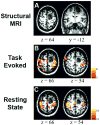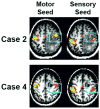Preoperative sensorimotor mapping in brain tumor patients using spontaneous fluctuations in neuronal activity imaged with functional magnetic resonance imaging: initial experience
- PMID: 19934999
- PMCID: PMC2796594
- DOI: 10.1227/01.NEU.0000350868.95634.CA
Preoperative sensorimotor mapping in brain tumor patients using spontaneous fluctuations in neuronal activity imaged with functional magnetic resonance imaging: initial experience
Abstract
Objective: To describe initial experience with resting-state correlation mapping as a potential aid for presurgical planning of brain tumor resection.
Methods: Resting-state blood oxygenation-dependent functional magnetic resonance imaging (fMRI) scans were acquired in 17 healthy young adults and 4 patients with brain tumors invading sensorimotor cortex. Conventional fMRI motor mapping (finger-tapping protocol) was also performed in the patients. Intraoperatively, motor hand area was mapped using cortical stimulation.
Results: Robust and consistent delineation of sensorimotor cortex was obtained using the resting-state blood oxygenation-dependent data. Resting-state functional mapping localized sensorimotor areas consistent with cortical stimulation mapping and in all patients performed as well as or better than task-based fMRI.
Conclusion: Resting-state correlation mapping is a promising tool for reliable functional localization of eloquent cortex. This method compares well with "gold standard" cortical stimulation mapping and offers several advantages compared with conventional motor mapping fMRI.
Figures







References
-
- Adcock JE, Wise RG, Oxbury JM, Oxbury SM, Matthews PM. Quantitative fMRI assessment of the differences in lateralization of language-related brain activation in patients with temporal lobe epilepsy. Neuroimage. 2003;18:423–438. - PubMed
-
- Arfanakis K, Cordes D, Haughton VM, Moritz CH, Quigley MA, Meyerand ME. Combining independent component analysis and correlation analysis to probe interregional connectivity in fMRI task activation datasets. Magn Reson Imaging. 2000;18:921–930. - PubMed
-
- Behrens TE, Woolrich MW, Jenkinson M, Johansen-Berg H, Nunes RG, Clare S, Matthews PM, Brady JM, Smith SM. Characterization and propagation of uncertainty in diffusion-weighted MR imaging. Magn Reson Med. 2003;50:1077–1088. - PubMed
-
- Binder JR, Swanson SJ, Hammeke TA, Morris GL, Mueller WM, Fischer M, Benbadis S, Frost JA, Rao SM, Haughton VM. Determination of language dominance using functional MRI: a comparison with the Wada test. Neurology. 1996;46:978–984. - PubMed
Publication types
MeSH terms
Grants and funding
LinkOut - more resources
Full Text Sources
Other Literature Sources
Medical

